For the first 21 years of her life, Kilsi Rodríguez couldn’t describe her curl pattern. Up to that point in her life, she had spent 14 years relaxing her hair with harsh chemicals, draining the life out of her 4A/4B coils in the process. “It was a long time of me not at all accepting my hair or even knowing what my actual hair looked like,” Rodríguez tells me in a phone interview. “I didn’t officially decide to go on my journey until my senior year of college.” Roughly six years later, Rodríguez is a natural hair vlogger who is empowering other women to love their hair through her videos and her inaugural Afros & Rizos, an event that took place this past weekend in Brooklyn.
At the Umbrella Factory Saturday evening, 150 women with varying textures gathered to bond over the natural hair movement that has a strong presence online. The event attracted women of different ages and backgrounds, who came ready to play natural journey Jenga (where each wooden block included a question or positive affirmation), exchange products and tips, create flower crowns, and make inspirational buttons. The attendees made their way around the space – big enough to fit 200 people – eating empanadas and Mamita’s Ice as well as enjoying cocktails. They asked their friends or women they just met to take photos of them in front of the purple Afros y Rizos sign illuminated by a ring light. When the space felt too warm, they gathered on the rooftop to cool down and snap selfies in front of a geometric mural.
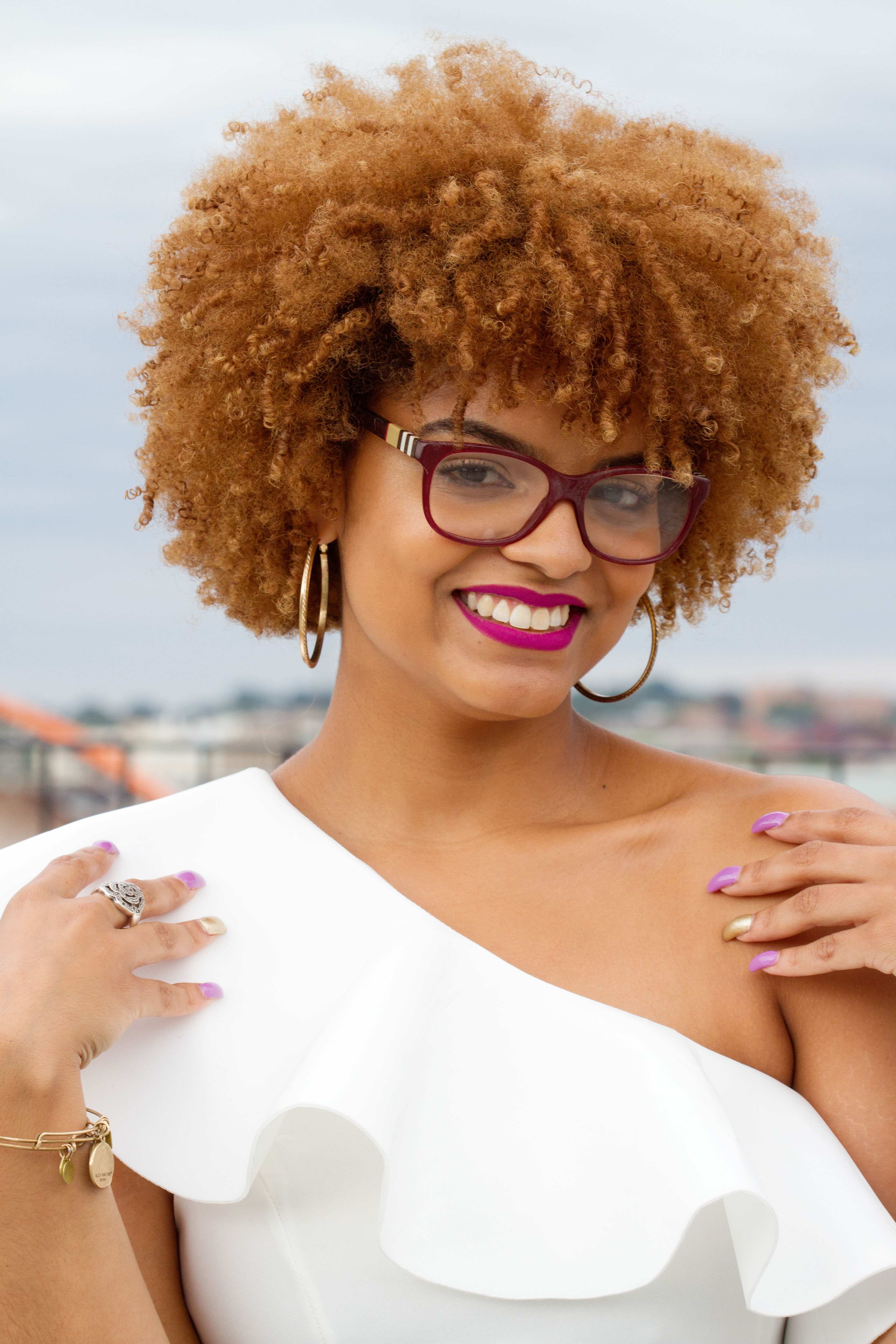
The impressive, yet intimate event is something Kilsi – better known to her 3,000+ YouTube and 37,000 Instagram followers as Le Frosie – began planning in January. As a frequent attender of other hair events, Kilsi knew she wanted to host her own one day. But she waited until she built a decent following “to make sure that people would want to come to my event.”
Kilsi balanced planning the event with her job teaching in a high school and coaching. You could feel Kelsi’s touch throughout. She modeled the event after an interactive lesson plan structure that she has employed in the classroom. Purple and gold – the colors she wore on her nail that day – decorated the space. This color scheme is present on her social media accounts, particularly her logo. But the event would have been hard to put on without the help of her friends and family, who put in a lot of work. Before the 5 p.m. start time, they hauled bags of ice and food, slowly transforming the bare space into a welcoming one. In their Afros & Rizos shirts – which said the word “Squad” on the back – they cheerfully greeted guests and fielded questions.
Their combined efforts ended in an event that brought together women who have at one point in their lives felt pressure to adhere to narrow beauty standards that don’t value all types of hair. Now, they’re fully embracing their curls and texture – even as straight hair remains a persistent beauty standard in society at large. The term “pelo malo” is still prevalent in salons, and as a 2016 Perception Institute confirmed, biases against afro-textured hair still exist.
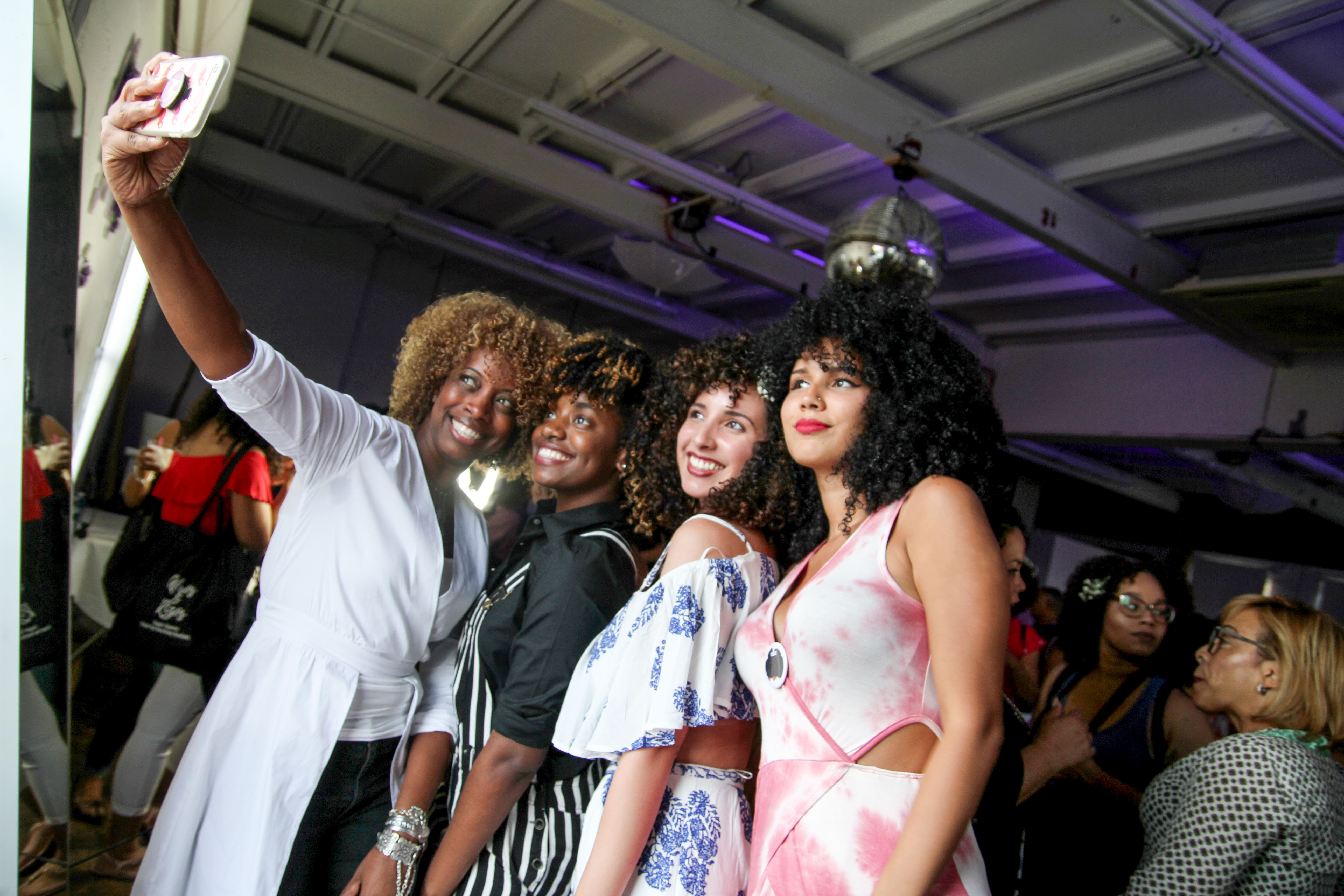
For Rodríguez, the road to self acceptance was about herself, but also about her family. “In the Dominican Republic… even just being curly is an issue, but if it’s kinky hair – kinkier hair, more coarse hair – that’s a huge issue. That’s not accepted. That’s ugly. That is bad hair. Almost every single person in my family has coarse hair, so you know, I wanted to be the person to be like, ‘Listen, our hair is beautiful.’ I try to spread that message consistently on my platform. Coarse hair is beautiful.”
It’s one reason she named the event named Afros & Rizos. Other hair events tend to center curls, which can shut out women with afro-textured hair. “I wanted to make sure I had an event that kind of was geared toward all women,” she adds. “I feel like when you use the word curl, curl, curl, you’re forgetting about a whole hair texture. Not everybody’s hair curls. I feel like I wanted to make sure the name of the event catered to all hair textures. So it’s not specifically only for Afro-Latinas.”
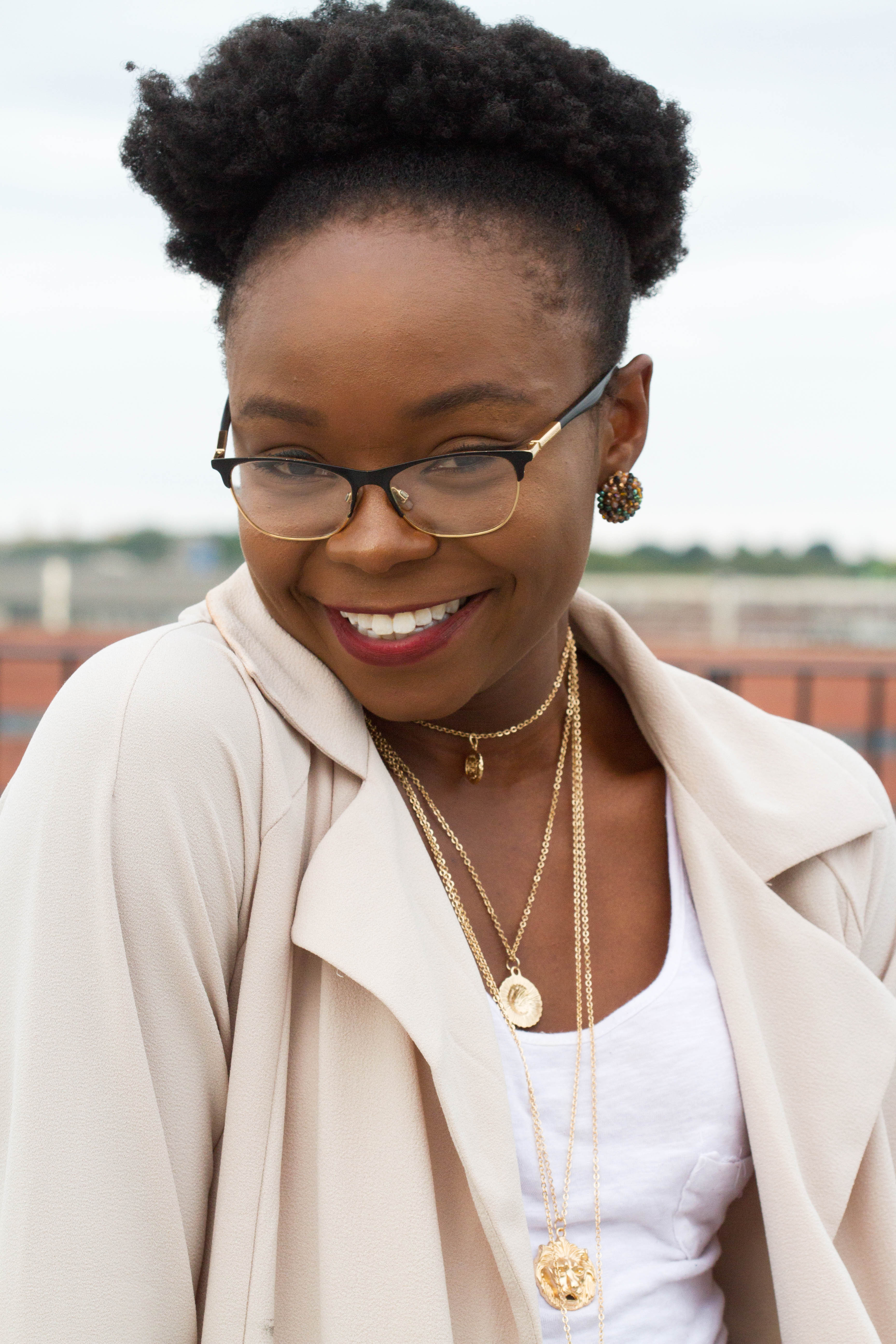
According to her estimates, about 80 percent of the guests were Latinas. But the event was inclusive. Kristen Russell, who is Jamaican and Trinidadian, came out to Afros & Rizos because she couldn’t make it out to this year’s CurlFest. This event gave her the opportunity to bond with others who have been on similar journeys and to support a woman of color. Cassandra Ehioghiren, who did make it out to CurlFest, attended because she’s all about supporting the natural hair movement. “Curly hair, different textured hair was something that wasn’t valued before,” she says. “And now, all of a sudden, it’s like a big phenomenon. “I think it’s amazing, so anytime I see events like this… I’m just like, ‘Let’s go. Let’s go.’”
At the event, we spoke to eight Latinas who embody the event’s tag line – Inspire. Empower. Create your own beauty standards. We talked to them about the first time they heard the words “pelo malo” and what they would tell their younger selves about feeling pressure to change their hair.
These interviews have been edited and condensed for clarity.
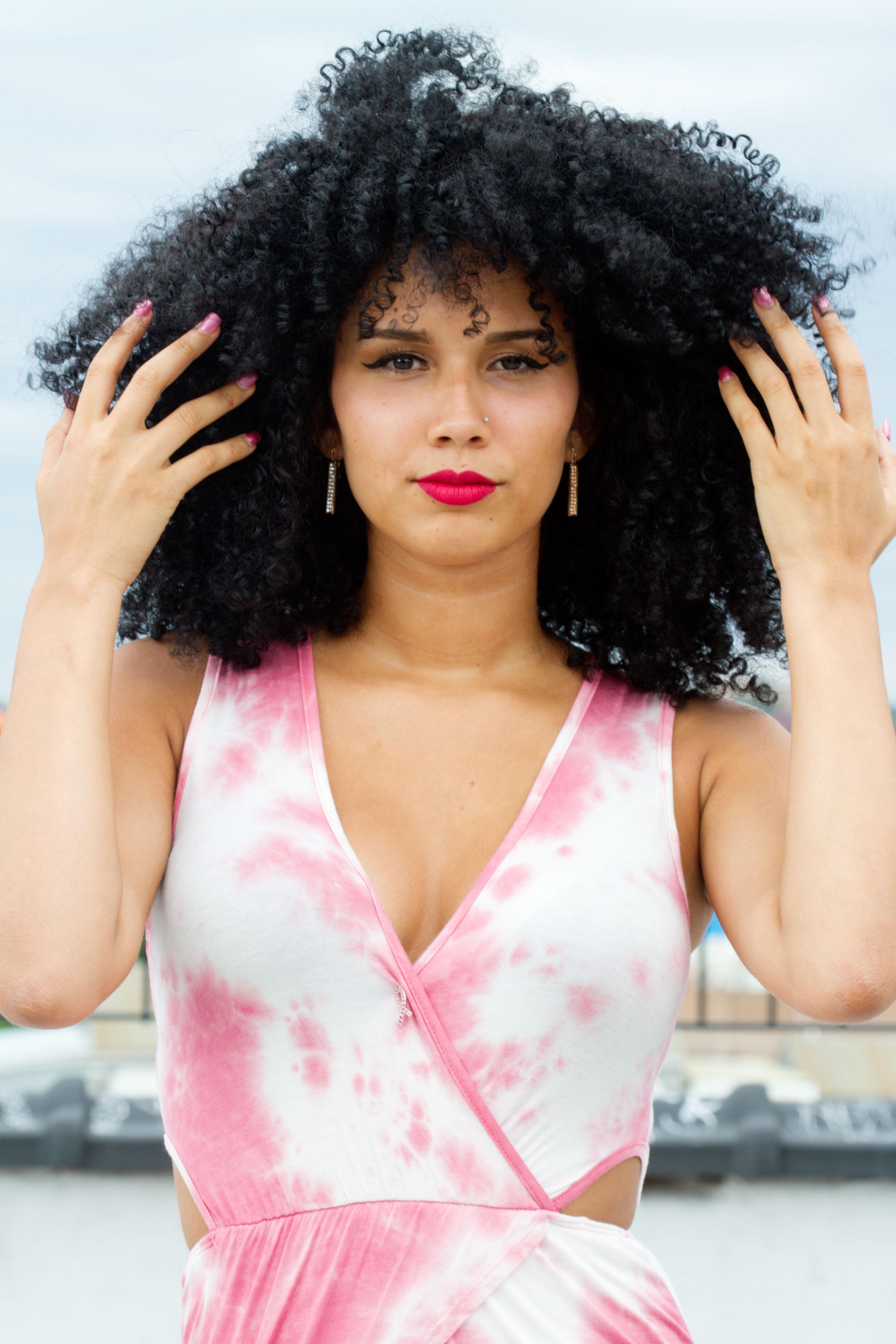
Maria Mosquera
Age: 22
Background: Colombian
“I used to see this straight-haired girls on the TV, and I wanted to be like them.”
The first time I heard the term “pelo malo,” it was like in 2011. It was actually someone from the Dominican Republic. They used that term, “pelo malo.” They’re like, “You don’t need to wear curly hair. It’s ‘pelo malo.’ You should straighten your hair.” And I was like, “No, actually. There’s no ‘pelo malo.’”
Growing up in Colombia, I never heard of “pelo malo,” but they would criticize curly hair as bad hair, so it was similar to “pelo malo.” I actually went natural in 2014. I was going to the salon every week, straightening my hair and there was a point that I was looking at myself in the mirror, and told myself, “I need to be natural. I need to be who I am, because I’m expressing myself with my hair.”
When I was younger, a lot of people used to tell me that curly hair was bad, and I used to see this straight-haired girls on the TV, and I wanted to be like them. I would tell my younger self to love myself. Curly hair is the best. I mean, every type of hair is beautiful. I would never, never change it, because being natural is being who you are.
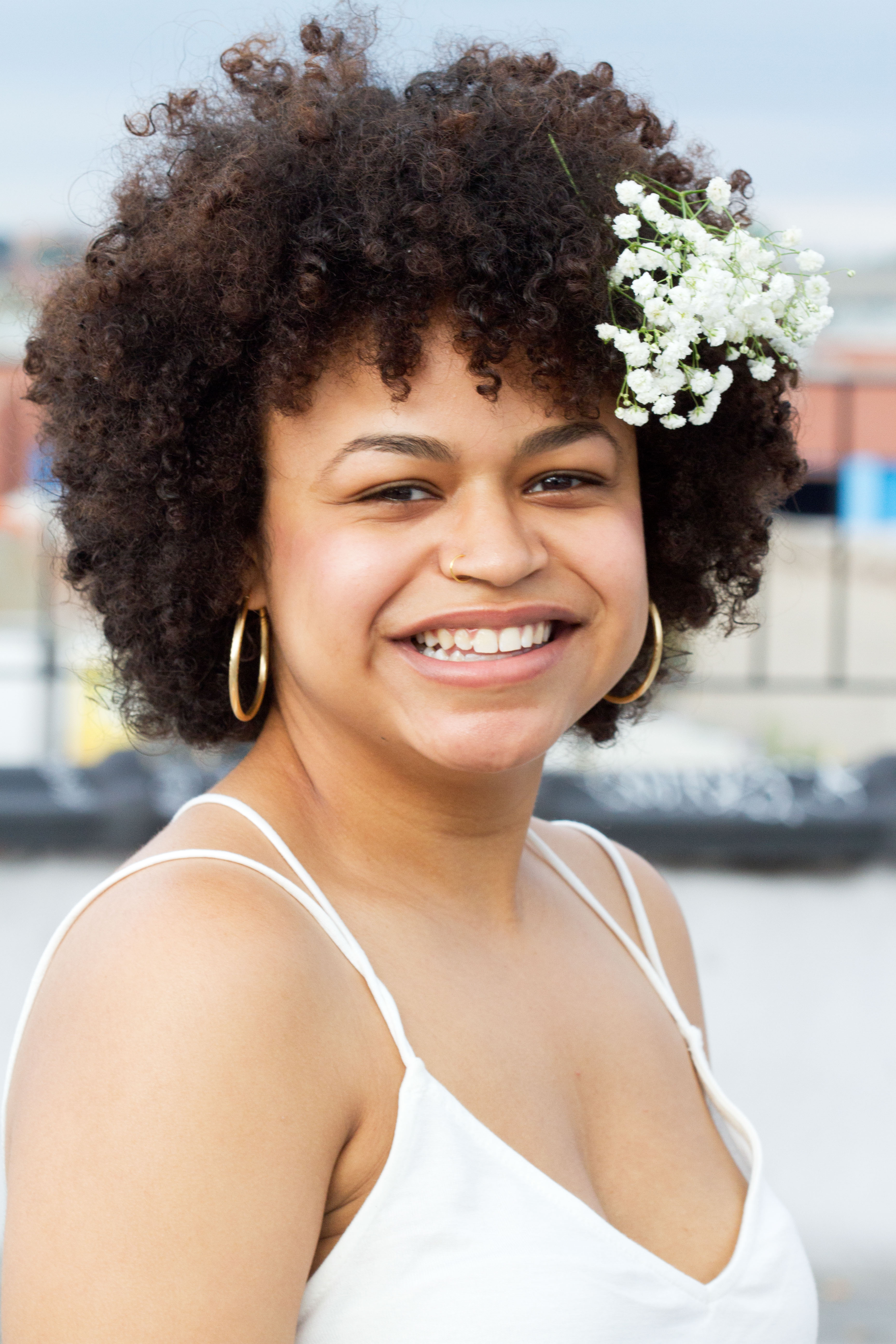
Sasha Huff
Age: 21
Background: Puerto Rican and African American
I’m really into natural hair, so I follow bloggers to try different styles. My friends told me that Kilsi and I resemble each other, and I started following her Instagram. I figured if hairstyles look nice on her, then they’ll probably look nice on me. Then I saw the Afros & Rizos event, and I was like, “Wow, I want to go out to meet her.”
“Pelo malo” wasn’t really used in my house. Both of my parents speak English, but the first time I heard it was maybe in college. Like I’ve heard people say bad hair, but I heard “pelo malo” in college when I went to a Latino Student Union event that broke down the term.
“I saw the perm burn a soda can, and I was like ‘What am I doing to my hair?’”
Being told I had bad hair as a kid made me get perms. It made me get perms in the fourth grade. Other students would tease me about my hair. I thought it’d make my hair more manageable. So I got perms for about four years. Then, that movie Good Hair by Chris Rock came out and totally changed my mindset about perms. And I decided to go natural, because I saw the perm burn a soda can, and I was like “What am I doing to my hair?”
I would tell my younger self that my hair is beautiful, that I’m beautiful the way that I am, and God created me this way for a reason. I would probably tell myself, “Don’t get a perm.” And if anybody tells you get a perm, don’t do it, because you’re going to mess up your hair, and it’s going to look horrible the way that it did in 2007.
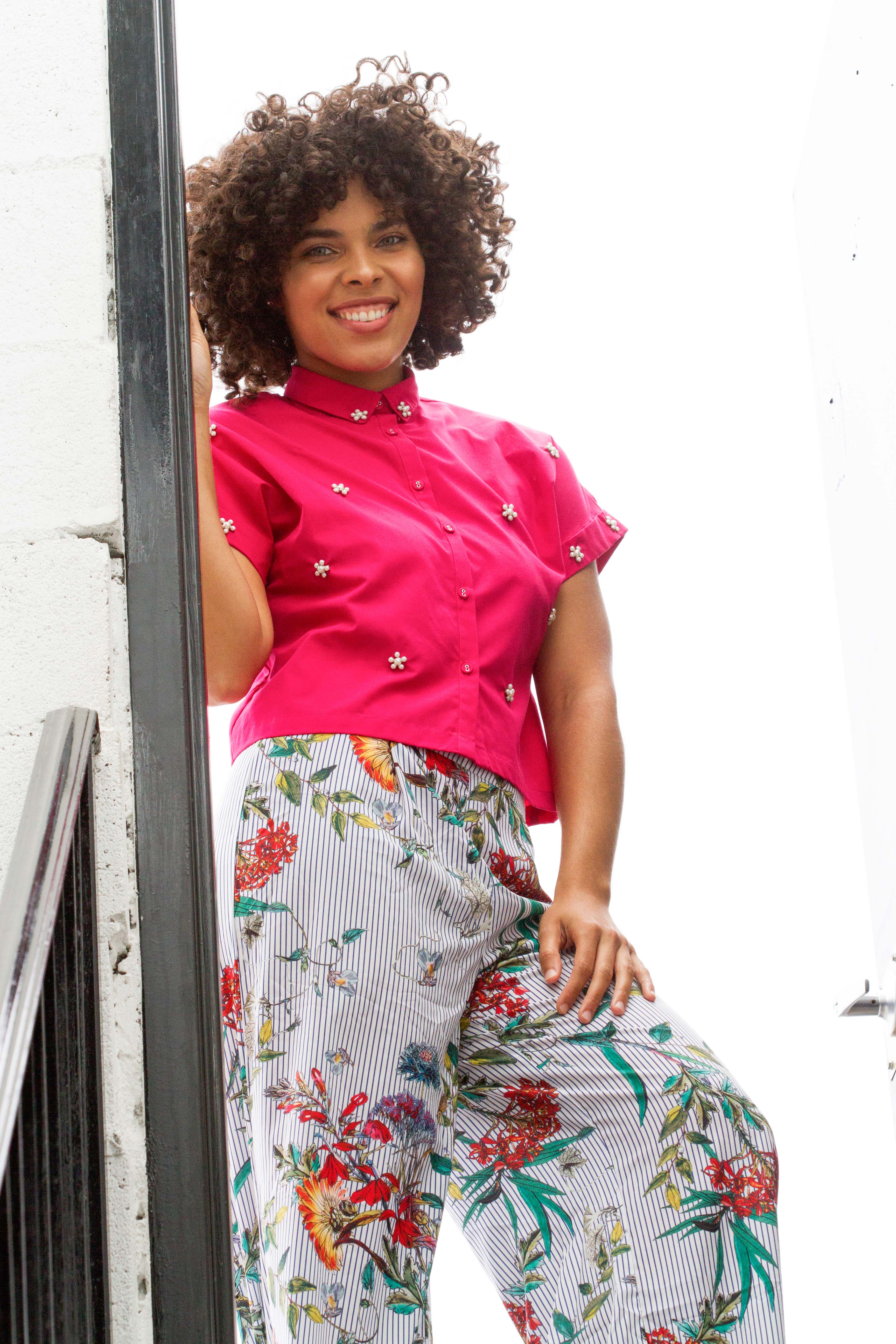
Jodelis Díaz
Age: 23
Background: Dominican
I came all the way for Philadelphia, so I’m so excited to be here. I’ve heard the term “pelo malo” my whole life. That’s why I decided to go natural. I decided to stop letting other people define what good hair is. Hearing that term, it made me not like my natural hair. So I decided every week, Saturday or Sundays, go straight to the salon and do my hair. I could not see a curl in my hair. If I did, I would freak out, because in my culture, it’s not what good hair is.
“[A lady at the salon said] ‘Wow, your hair is so dry.” In my head, I’m thinking, ‘You’re making my hair dry!’
When I first decided to go natural, I was in the Dominican Republic. I was in the salon, and a lady was straightening my hair. She’s like, ‘Wow, your hair is so dry.” And in my head, I’m thinking, “You’re making my hair dry!” After I left the salon, my hair smelled so bad. It stayed like that for months. It’s that awful, burnt hair smell. Even after washing it three times a day, it stayed. And that’s when I decided to go natural, like this cannot be good for my hair. It cannot. This smell. This texture. It cannot be good. And that’s what made me go natural.
My family said, “Why are you going natural?” You have curly hair already. I told them, “Just watch. This is not what it’s supposed to look like.” I saw people on Instagram. That was last year in 2016. It’s still not where I want it to be. I just got my hair cut on Wednesday, and she cut most of it all off, so I’m almost there. I’m almost there. One more cut, and I should be there.
I would tell my younger to self to embrace my hair. It’s good to be different. Stop straightening it. You’re gonna love yourself eventually, and it’s gonna be hard, but you can do it.
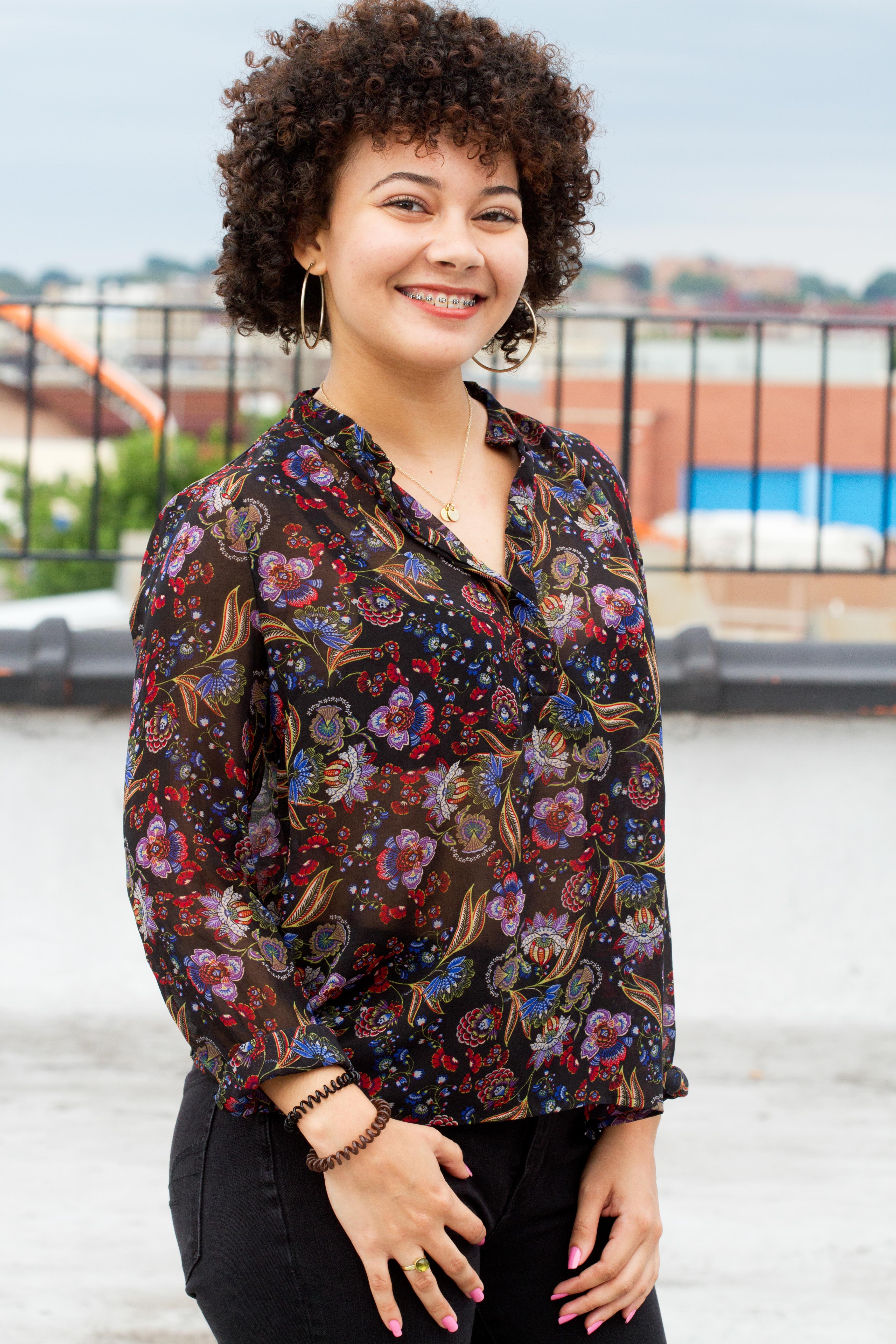
Corianny Rosario
Age: 20
Background: Dominican
I’ve been following Le Fosie on Instagram, and since I saw that she had this event, I was like, “Oh, I have to go,” because she really encouraged me when I was starting my journey. I really wanted to see her. When I came from the Dominican Republic a year ago and saw that most girls were having like having this big hair, like, “Oh, my hair was like that.”
In my country, it wasn’t something nice. But when I came here, it was like, nobody cares how you look, so let me just do what I’d like to do. And I’ve been a year transitioning from heat damage. I think I’ve heard the term “pelo malo” all my life. In DR, it’s since like you’re five years old, they’re already telling your mom, “Oh, esa niña con ese ‘pelo malo.’ You have to start either relaxing her hair or taking her to the salon every weekend.”
“I’m not guilty for having this type of hair.”
I tried not to pay too much attention to that phrase, “pelo malo.” But when it came from my family, it really hurt me, because it’s like wow, it’s something that is mine. And they’re blaming me for that. I’m not guilty for having this type of hair, but then, when I started to transition, my mom was like, “Are you crazy?” But then, she just let me be.
I feel OK where I am right now in my hair journey. I had the damage like four years ago. I feel comfortable with it how it is right now, and I’m not the type of girl that I say, “Oh, I want this girl’s type of curls” or “I want those type of curls.” No. I like my hair how it is. I already know how it is.
I would tell my younger self not to get influenced by others or by others’ look, because growing up, I wanted to be like the others. That’s why I used to go to the salon every weekend and straighten my hair, but if I hadn’t compared myself so much, maybe I would never have had to start the journey again.
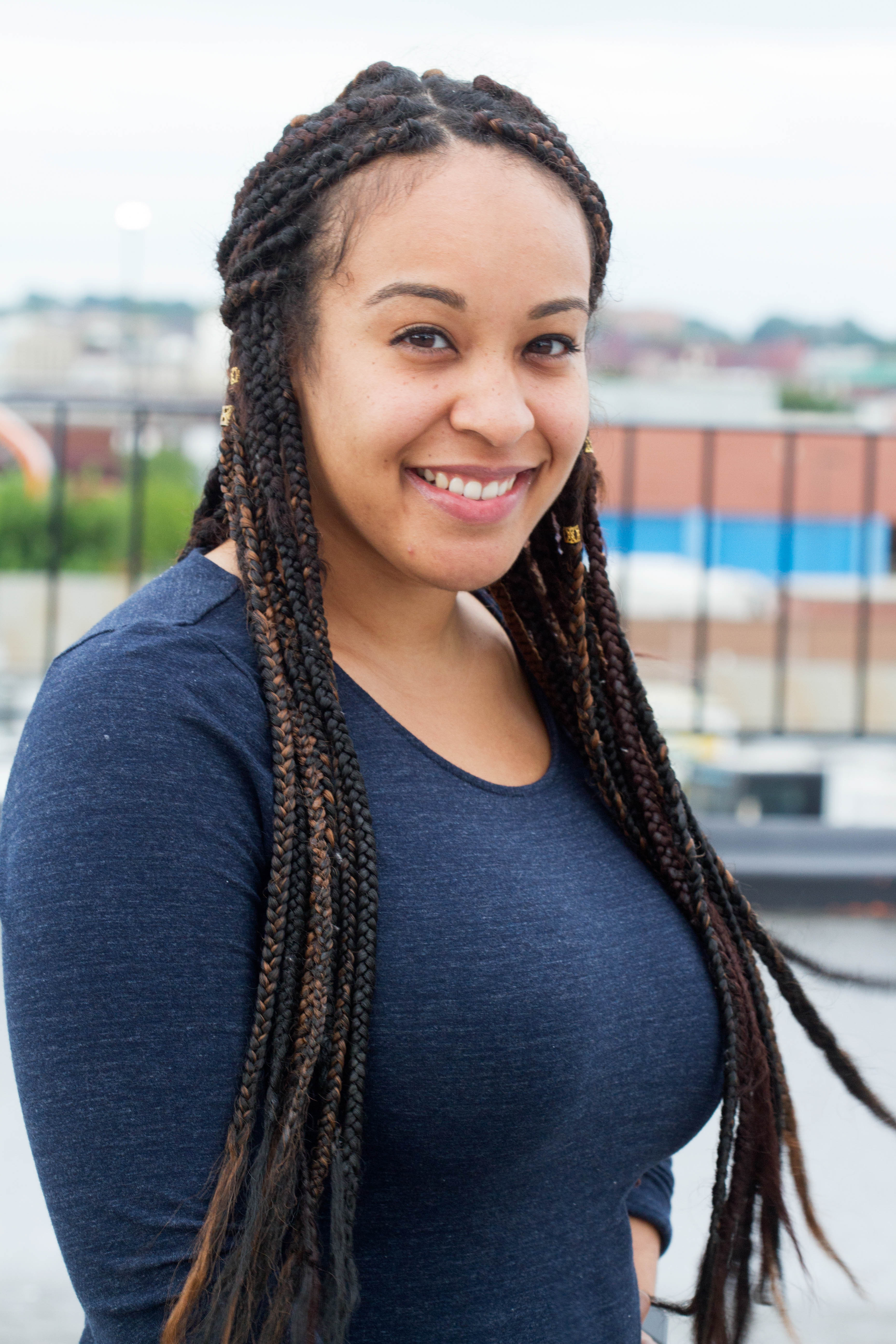
Shamira Alvarez
Age: 24
Background: Dominican
I’ve heard the term “pelo malo” since I was a kid. I guess like since I was born. I got a relaxer by force. It wasn’t by choice. I remember I was like 5 or 6, but it wasn’t because of my mom. My dad sent me to a hair salon, and he didn’t know any better. And they were like, “Oh yeah, we’re gonna do something to make it mejor, pa’ suavizarlo. My dad was like OK, and they relaxed the shit out of my hair. My mom was pissed. But then after that, since it was messed up, I had to keep doing it. I stopped when I was 13, because I used to dye my hair, so I could only choose one: Either dye or straighten. So I was like, I’d rather dye it, so I decided to grow it out.
“I got a relaxer by force. It wasn’t by choice.”
I wasn’t really conscious of what “pelo malo” meant or if it was hurtful or anything. It was like, “Oh, yo tengo ‘pelo malo.’” But now thinking about it, it’s like, damn that’s so fucked up to say that someone’s hair is bad because it curled or whatever.
If I could go back in time, I would tell myself to not dye it. I used to put so many things in it. I used to put that lightening gel that has bleach in it. I used to that. I used to do a lot of bad shit to myself. I would just keep it natural because I had really nice hair once upon a time. My hair has gotten a lot better. My first big chop was last year, last May in 2016. I just did another big chop this June. My hair’s really short now. It all curls now, except for one little spot in the front, so I’m just working on that. And this is why I have braids, because in the summer, I hate having short hair.
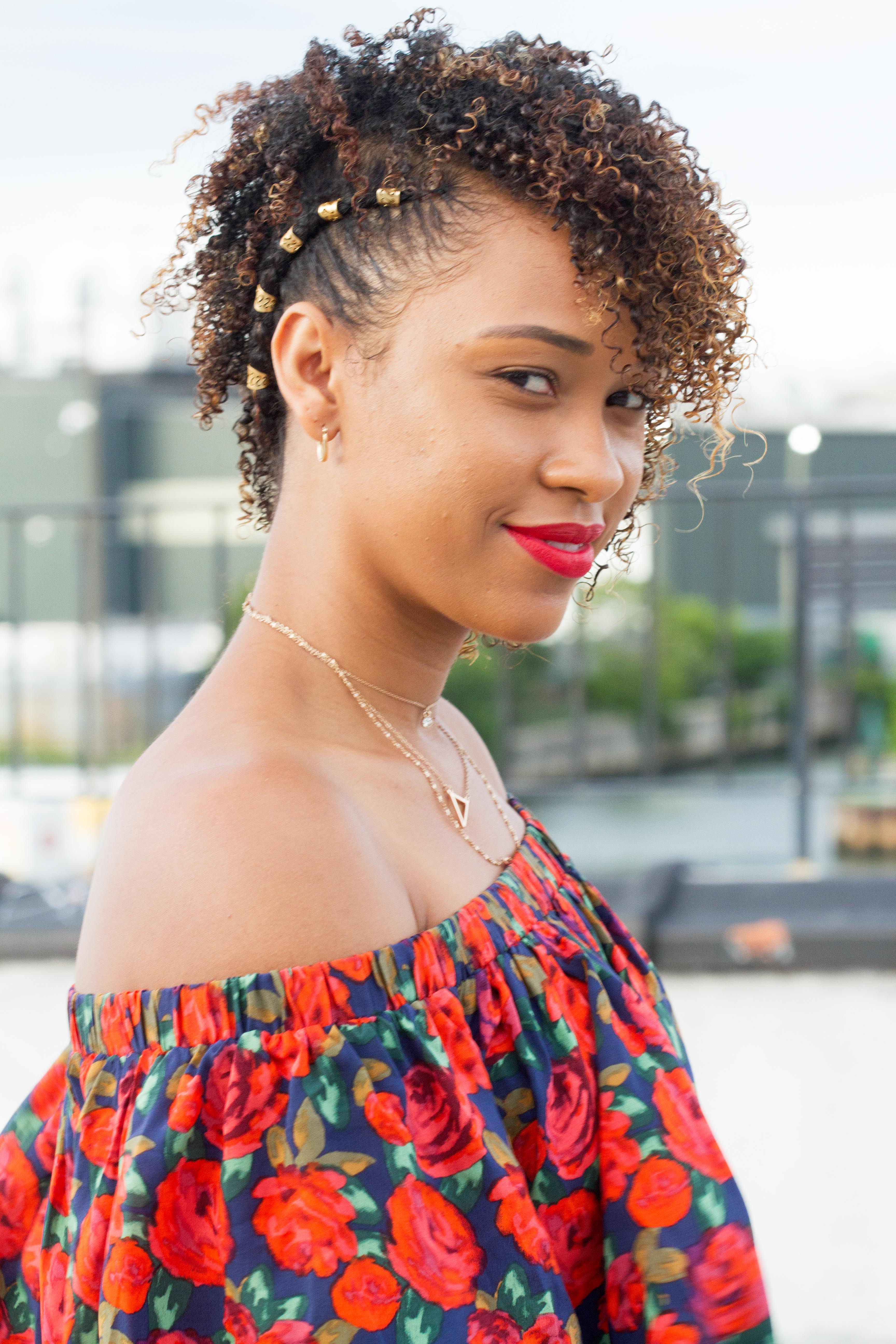
Brisa Cruz
Age: 30
Background: Dominican
Since I have like memories, since I was a little girl, they used to say – and me, myself I used to say – “pelo malo.” It made me feel like that was normal, because I used to tell myself, “Oh, I have ‘pelo malo.’” So to me, it was like normal until I started discovering there was nothing wrong with my hair. So at that point, I stopped referring to my hair, and other people’s hair, as “pelo malo.”
Three years ago, I began to transition to natural hair. I remember when I was a little girl, I used to love curly hair, but my hair didn’t curl, because my mom didn’t know how to do that. She’d only do moños and stuff like that. So three years ago, my hair was so damaged. I discovered this revolution of you letting your hair grow naturally, so I decided I wasn’t gonna do any more heat, because I was not doing perms. But I was still using a lot of heat and tintes. So in 2014 is when I started.
“Still to this day, sometimes I go to the hair salon and get my hair straightened and they’ll say, ‘Asi es que te ves bonita.’
I would tell my younger self that my natural hair is beautiful. That there’s nothing wrong with my hair. That my hair is not “pelo malo,” and just to embrace it.
I never remember my hair like this because my mom, she never did it like that. My mom, she used to do only little braids or moños. Nothing like this. I discovered my hair when I used to have like the perms and when they wear off, you could feel like the root, and I could feel a little curl. So I realized my hair could curl. I was very curious about it, but I never did it. I never had the courage to do it.
Until one day, I went for it. I told my boyfriend, “Baby, cut my hair.” And he cut it, the big chop. And you know after that, a lot of people were like, “What’s wrong with you girl? Tu quieres ser una morena?” They used to tell me things like that. Still to this day, sometimes I go to the hair salon and get my hair straightened and they’ll say, “Asi es que te ves bonita.”
But I realized, that’s my culture, especially the older people, that’s the mentality that they have. I’m not going to change their minds. So I just pay no mind to them. And people that ask me for advice about it, I told them that: “Don’t pay mind to people. You’re not gonna please anybody. If you feel good about it, do it.”
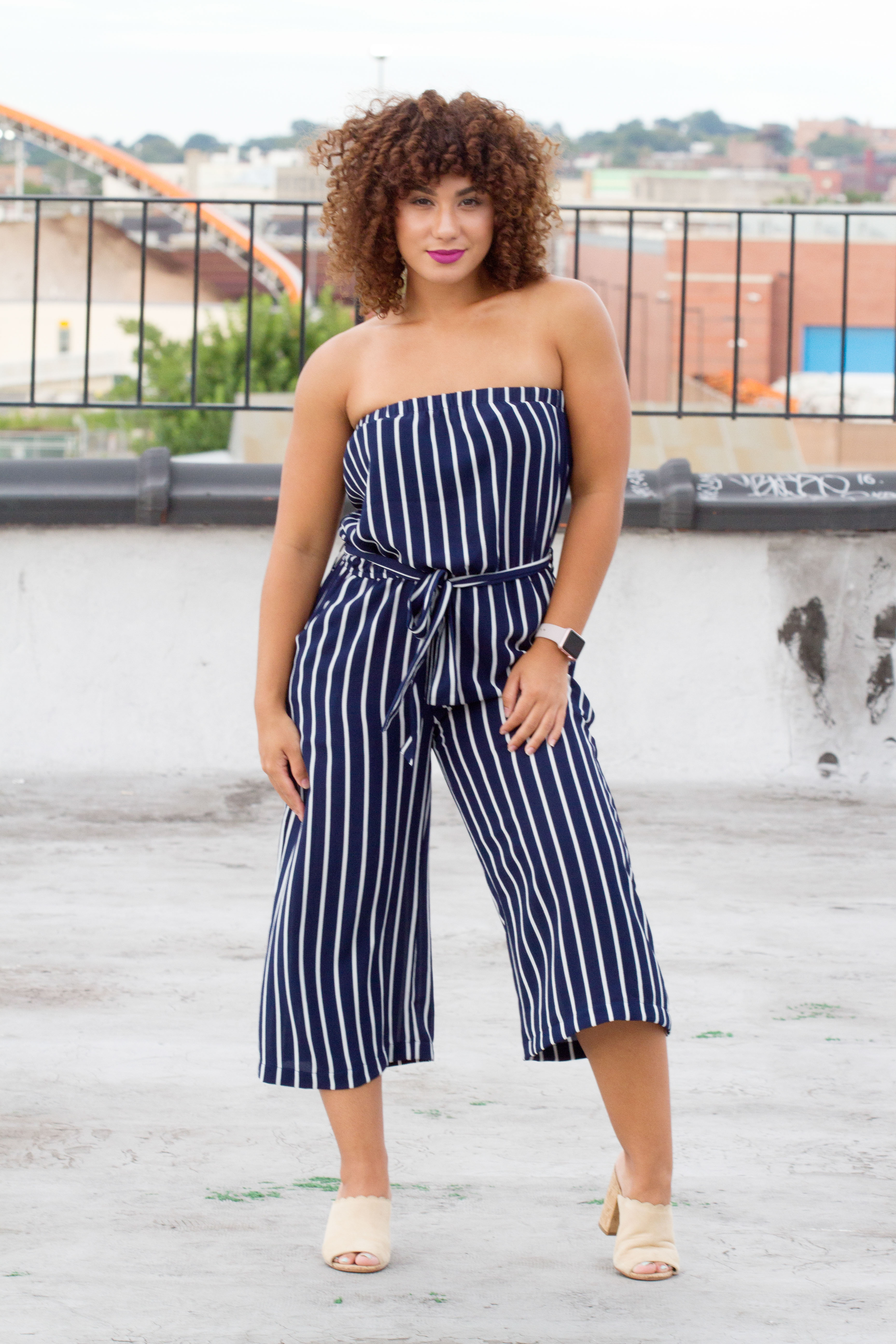
Kiara Cruz
Age: 23
Background: Dominican
So I’ve been a curly guru for the past, I want to say, two years. I officially committed in January when I got my first curly cut. I’m all about curl events, and I love events that are up-and-coming. So that’s what drew me to Afros y Rizo, especially because this is Afro-Latina-centered. That’s my roots, and I always wanna embrace my roots and be around people who have similar experiences as me. I like this event in terms of when I compare it to CurlFest. It was hard to interact with others. CurlFest is more on a national level. It was so much. But I felt like this one was gonna be more intimate, more getting to know other girls like you, other girls who are on the same journey as you and learning from each other.
“It made me feel that my hair type wasn’t good enough.”
I’ve heard the term “pelo malo” since I was like 2. Since I could remember. It made me feel that my hair type wasn’t good enough. It wasn’t lacio enough. Like my hair wasn’t enough, basically.
In the last couple of years, I want to say like two to three years ago, I really cut my hair and was not straightening it. So I hadn’t flat ironed it with a straightener for five years, but I was still not using the right products, and I wasn’t really taking care of it. Then in January, I threw out all the products that had parabens and sulfates and all the bad monsters, and I really committed to taking care of my hair. Because I can cut it, but cutting is, is only the first step. Maintenance is the biggest step. And if you have curly hair, it is way more work than straight hair.
I would tell my younger self that your hair is beautiful. It’s a part of who you are. And whether it’s curly, kinly, straight, wavy, it’s part of your unique beauty and no one has your hair. No one. There’s other styles and you might be a 2C, 2B, 3A, 3B, but no one has your type of hair, and no one has the body to flaunt your hair. So you have to do the best of what you can with your hair.
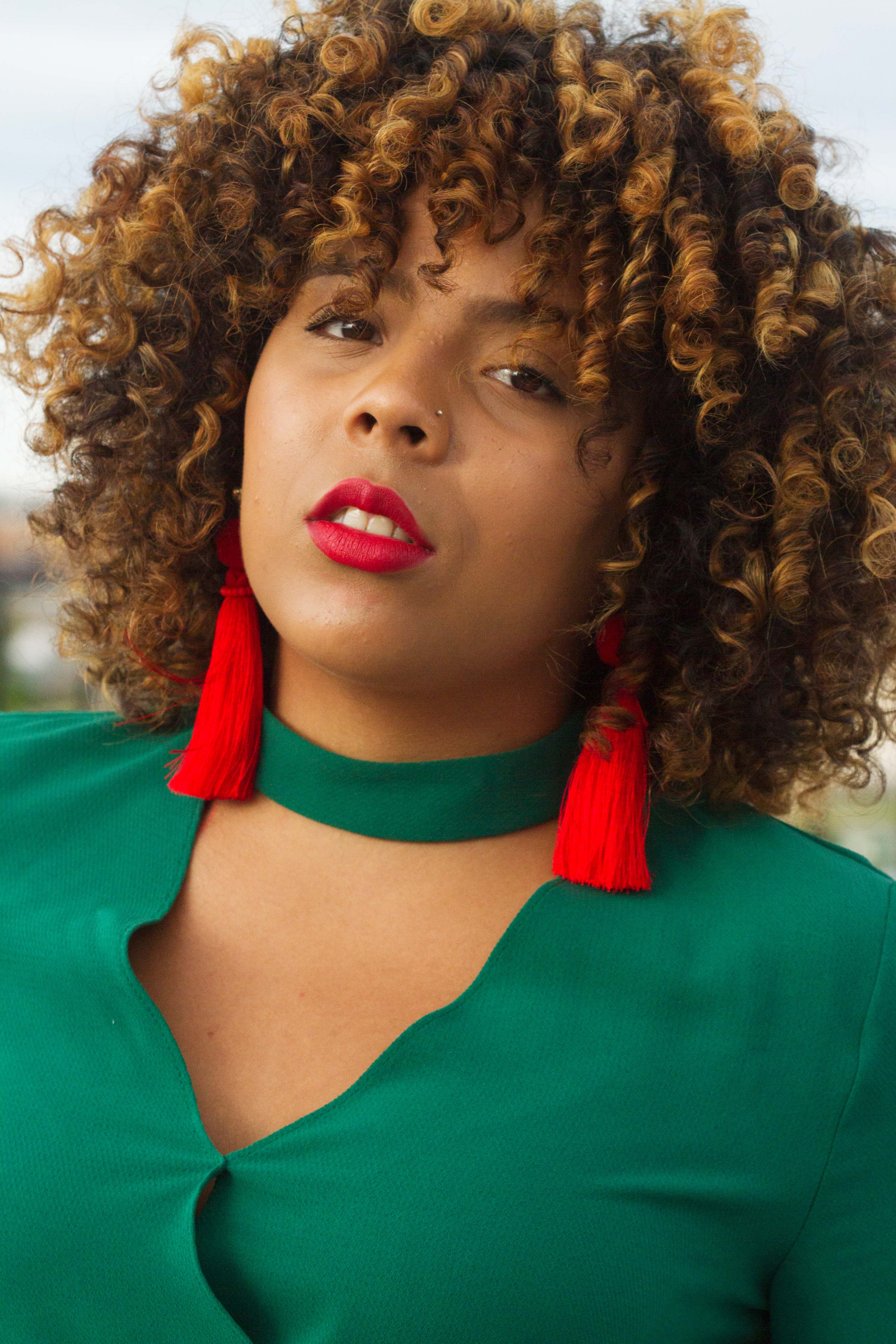
Karla Arroyo
Age: 21
Background: Dominican
I always felt like the gap in beauty was very big, and I feel like curly hair was kind of missing in that. It wasn’t really appreciated before, and now it’s great to see a lot of people coming together and even hosting events on curly hair appreciation. That’s what pretty much brought me here. And also, because my friend told me about it, and I heard about all the things they were gonna have here, so I just thought it was a great opportunity.
“It’s great to see a lot of people coming together and even hosting events on curly hair appreciation.”
The first time I heard “pelo malo” I was probably like four years old. My hair is naturally curly, but for a while I didn’t appreciate it. I didn’t like it. I would not dare to go out to a fancy event without my hair blow dried. I actually ruined my hair about three years ago. I dyed it red. I bleached it. I was using a flat iron. I even forgot I had curly hair.
And then a year ago, I started missing my curly hair. I decided I just wanna wake up one day, wash my hair and go instead of having to blow dry it and worry about it getting wet with the rain. So that’s when I started my transition, and it took me about a year and four months. What I was doing, I was just cutting my hair very slowly. Then, when it came to like the end of the period, I just did like a really big chop then. From there, that’s where I started using good products for my hair and appreciating my curls.
I would tell my younger self to appreciate it. It’s the natural crown you wear on your head. It does require a lot of work to maintain it, of course, but it’s just that you don’t have to process it and stay in the hair dryer for an hour burning yourself. So I would definitely tell myself don’t use flat irons and don’t dye it without a safe method.







